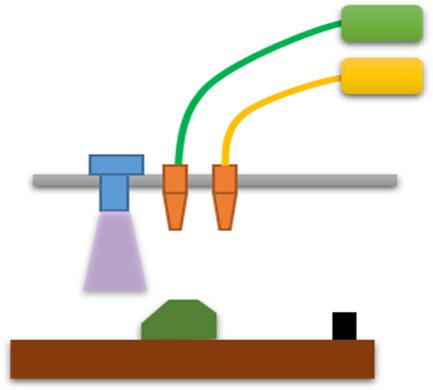当前位置:
X-MOL 学术
›
Adv. Eng. Mater.
›
论文详情
Our official English website, www.x-mol.net, welcomes your feedback! (Note: you will need to create a separate account there.)
Microadditive Manufacturing Technologies of 3D Microelectromechanical Systems
Advanced Engineering Materials ( IF 3.6 ) Pub Date : 2021-09-06 , DOI: 10.1002/adem.202100422 Hany Hassanin 1 , Ghazal Sheikholeslami 1 , Pooya Sareh 2 , Rihana B. Ishaq 1
Advanced Engineering Materials ( IF 3.6 ) Pub Date : 2021-09-06 , DOI: 10.1002/adem.202100422 Hany Hassanin 1 , Ghazal Sheikholeslami 1 , Pooya Sareh 2 , Rihana B. Ishaq 1
Affiliation

|
Conventional microfabrication processes have been well established, but their capabilities are generally limited simple and 2D extruded geometries. Additive manufacturing allows the ability to manufacture true 3D complex geometries, rapid design for manufacturing, mass customization, materials savings, and high precision, which have triggered the increased interest in manufacturing microelectromechanical systems (MEMS). Herein, MEMS manufacturing's recent advancements, including both conventional and additive manufacturing technologies, their working principles, and practical capabilities are consolidated. The use of additive manufacturing in several MEMS areas such as in microelectronics, circuitry, microfluidics, lab on a chip, packaging, and structural MEMS is also discussed in detail. Furthermore, the potentials and limitations of additive manufacturing are investigated with regard to the MEMS requirements. Finally, the technology outlook and improvements are discussed. This study shows that additive manufacturing offers a promising future for the fabrication of MEMS, especially using high-resolution techniques such as microstereolithography, materials jetting, and materials extrusion. In contrast, current challenges such as materials requirements, equipment innovation, fabricating of in vivo devices for biomedical applications, inherited defects and poor surface finish, adhesion to substrates, and productivity are areas that require further study to increase the uptake by the MEMS community.
中文翻译:

3D微机电系统的微增材制造技术
传统的微加工工艺已经很好地建立,但它们的能力通常有限,简单和 2D 挤压几何形状。增材制造能够制造真正的 3D 复杂几何形状、制造的快速设计、大规模定制、材料节省和高精度,这些都引发了对制造微机电系统 (MEMS) 的兴趣。在这里,MEMS 制造的最新进展,包括传统和增材制造技术、它们的工作原理和实践能力得到了巩固。还详细讨论了增材制造在多个 MEMS 领域的应用,例如微电子、电路、微流体、芯片实验室、封装和结构 MEMS。此外,根据 MEMS 要求研究了增材制造的潜力和局限性。最后,讨论了技术前景和改进。这项研究表明,增材制造为 MEMS 的制造提供了一个充满希望的未来,尤其是使用高分辨率技术,如微立体光刻、材料喷射和材料挤出。相比之下,当前的挑战,如材料要求、设备创新、生物医学应用的体内设备制造、遗传缺陷和表面光洁度差、对基材的粘附性和生产力是需要进一步研究的领域,以增加 MEMS 的应用社区。这项研究表明,增材制造为 MEMS 的制造提供了一个充满希望的未来,尤其是使用高分辨率技术,如微立体光刻、材料喷射和材料挤出。相比之下,当前的挑战,如材料要求、设备创新、生物医学应用的体内设备制造、遗传缺陷和表面光洁度差、对基材的粘附性和生产力是需要进一步研究的领域,以增加 MEMS 的应用社区。这项研究表明,增材制造为 MEMS 的制造提供了一个充满希望的未来,尤其是使用高分辨率技术,如微立体光刻、材料喷射和材料挤出。相比之下,当前的挑战,如材料要求、设备创新、生物医学应用的体内设备制造、遗传缺陷和表面光洁度差、对基材的粘附性和生产力是需要进一步研究的领域,以增加 MEMS 的应用社区。
更新日期:2021-09-06
中文翻译:

3D微机电系统的微增材制造技术
传统的微加工工艺已经很好地建立,但它们的能力通常有限,简单和 2D 挤压几何形状。增材制造能够制造真正的 3D 复杂几何形状、制造的快速设计、大规模定制、材料节省和高精度,这些都引发了对制造微机电系统 (MEMS) 的兴趣。在这里,MEMS 制造的最新进展,包括传统和增材制造技术、它们的工作原理和实践能力得到了巩固。还详细讨论了增材制造在多个 MEMS 领域的应用,例如微电子、电路、微流体、芯片实验室、封装和结构 MEMS。此外,根据 MEMS 要求研究了增材制造的潜力和局限性。最后,讨论了技术前景和改进。这项研究表明,增材制造为 MEMS 的制造提供了一个充满希望的未来,尤其是使用高分辨率技术,如微立体光刻、材料喷射和材料挤出。相比之下,当前的挑战,如材料要求、设备创新、生物医学应用的体内设备制造、遗传缺陷和表面光洁度差、对基材的粘附性和生产力是需要进一步研究的领域,以增加 MEMS 的应用社区。这项研究表明,增材制造为 MEMS 的制造提供了一个充满希望的未来,尤其是使用高分辨率技术,如微立体光刻、材料喷射和材料挤出。相比之下,当前的挑战,如材料要求、设备创新、生物医学应用的体内设备制造、遗传缺陷和表面光洁度差、对基材的粘附性和生产力是需要进一步研究的领域,以增加 MEMS 的应用社区。这项研究表明,增材制造为 MEMS 的制造提供了一个充满希望的未来,尤其是使用高分辨率技术,如微立体光刻、材料喷射和材料挤出。相比之下,当前的挑战,如材料要求、设备创新、生物医学应用的体内设备制造、遗传缺陷和表面光洁度差、对基材的粘附性和生产力是需要进一步研究的领域,以增加 MEMS 的应用社区。



























 京公网安备 11010802027423号
京公网安备 11010802027423号